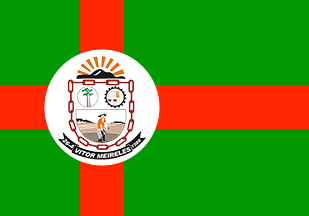 image by
Ivan Sache,
8 November 2021
image by
Ivan Sache,
8 November 2021 
Last modified: 2021-12-11 by ian macdonald
Keywords: santa catarina | vitor meireles |
Links: FOTW homepage |
search |
disclaimer and copyright |
write us |
mirrors
 image by
Ivan Sache,
8 November 2021
image by
Ivan Sache,
8 November 2021
The municipality of Vitor Meireles (5,156 inhabitants in 2014; 37,156 ha) is
located 270 km north-west of Florianópolis.
Vitor Meireles was settled in
1935 as Rio Preso; this odd name (Stuck River) refers to the local geography,
the river being "stuck" between ravines and forests. In 1945, the place was
renamed to Alto Rio Dollmann, and, subsequently, to Forcaçao (Forked Junction),
a reference to the fork formed by the confluence of rivers Fachinal and Palmitos.
In 1967, the writer Alceste Moser proposed to the Municipal Chamber of Ibirama
to change the name of Forcaçao to Vitor Meireles, as a tribute to the famous
Santa Catarina-born painter Victor Meirelles (1832-1903)
The municipality of
Vitor Meireles was established by State Law No. 7,579 promulgated on 26 April
1989 and inaugurated on 1 January 1990.
The country's main reserve of
araucarias is located in Vitor Mereiles, as an Area of Ecological Relevant
Interest. Covering 4,604 ha, it forms one of the last remains of the Santa
Catarina Atlantic rainforest, with more than 8,000 native Brazilian pines, some
of them older than 200 years.
https://www.vitormeireles.sc.gov.br
Municipal website
Ivan Sache, 8 November 2021
The flag of Vitor Meireles is prescribed by Municipal Law No. 38 promulgated
on 23 April 1990.
Article 1.
The municipal flag is described as
follows: On a green field, two perpendicular red stripes quartering the green
field. Over the imaginary intersection of the red stripes and the adjacent green
parts, a white circle inscribing the coat of arms of the municipality.
Article 2.
The design of the municipal flag obeys the following rules: on a
green field, of 130 cm in length on 90 cm in width, two perpendicular red
stripes of 18 cm in width. The horizontal stripe shall divide the green field in
two equal parts of 36 cm each on the whole length of 130 cm; the vertical stripe
shall divide the green stripes into two parts, the one at the viewer's left of
22 cm and the one on the viewer's right of 60 cm, the two stripes extending on
the whole width of 90 cm. In the center matching the geometric center of the
area generated by the crossing of the two red stripes shall be placed a white
circumference of 48 cm in diameter, charged in the center with the arms of the
municipality.
https://leismunicipais.com.br/a/sc/v/vitor-meireles/lei-ordinaria/1990/4/38/lei-ordinaria-n-38-1990-institui-as-cores-e-a-bandeira-do-municipio-e-da-outras-providencias
Leis Municipais database
The coat of arms of Vitor Meireles is
prescribed by Municipal Law No. 37 promulgated on 23 April 1990.
Article
1.
The municipal coat of arms is described as follows: Iberian shield
surrounded by a red chain. On a white field, in the upper left canton, a black
cogwheel surrounding, orled by a black circle, a factory with yellow windows and
chimneys, with black outlines and furnace. In the shield's lower part,
surrounded by a black semi-circle, a farmer holding a hoe in the foreground of a
cultivated area, with black outlines and green, yellow and white background. The
shield surmounted by green mountains under yellow sun rays. Beneath the shield a
green scroll outlined in black inscribed in white "VITOR MEIRELES", "26-4" and
"1989".
Article 2.
The heraldic elucidation is the following. The
shield, of Iberian style,
is shaped like a semi-circle surrounded by a chain,
representing the inhabitants' spirit of union. The scroll identifies the
municipality's name and date of political emancipation. The mountains and the
stylized sun rays represent the municipality's topography and promising future,
through a spirit of hope, optimism and confidence in the prosperity of the
municipality's horizon. The stylized araucarias represent forests and the timber
extraction history, so connected to the municipality's past and present vocation
and income. The stylized cogwheel and factory represent the municipality's
dynamism and present and future vocation. The farmer, his hoe and the cultivated
area represent the municipality's rural vocation and the integration of man with
land, which, cultivated with care, force and dedication, supplies harvests,
support and life.
https://leismunicipais.com.br/a/sc/v/vitor-meireles/lei-ordinaria/1990/4/37/lei-ordinaria-n-37-1990-institui-as-armas-do-municipio-e-da-outras-providencias
Leis Municipais database
Photo
https://www.facebook.com/prefeituradevitormeireles/photos/2320917667965328
Ivan Sache, 8 November 2021